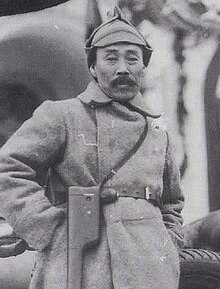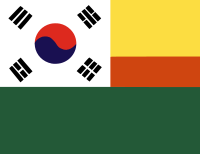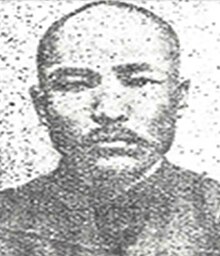List of militant Korean independence activist organizations
They functioned as a big tent political movement that represented a wide array of ideologies, including democracy, socialism, nationalism, communism, and anarchism.In one period, according to Japanese records in Boto Tobatsu-shi (Annals of the Subjugation of the Insurgent), between October 1907 and April 1908, over 1,908 attacks were made by the Korean people against the invaders.Given the ensuing suppression and hunting down of activists by the Japanese, many Korean leaders went into exile in Manchuria, Shanghai and other parts of China, where they continued their activities.[citation needed] Although the Free City Incident depleted their manpower, many resistance forces advocated for an autonomous region for Koreans to replenish their military and promote their independence movement.However, members of the Heroic Corps thought that those organizations were too moderate and would not contribute to independence in Korea, and instead took a more radical approach by opposing compromising solutions such as culturalism.[17][18] By March 1920, Hong was allied with the Military Affairs Command to provided a boost to the national spirit of Koreans everywhere and prompted further armed resistance struggles in Manchuria.[17][18] The army had moved its base from Antuhyun to Fengwudong, Wang Qinghyun, China and received financial support from the Korean People's Association for a larger domestic resistance operation.In November, this unit merged with Han Chang-geol's Suqing army and Park Gyeong-cheol's New People's Corps (Shimindan) at Trechii-pujin, a Korean village in the Chuguyev Valley.[27] In Nov. 28, 1920, they moved to Baededun, Ohun County, Heilongjiang Province, Manchuria, and officially named the unit the Korean Patriotic Youth Blood Corps."[29] In early 1921, they moved to Iman, Maritime Province, then crossed over to Free City to engage in independence activities.Then Chae young and Jo Maeng-seon left for Irkutsk with Kim Gyeong-cheon's troops.Son Pungik was shot to death, and the integrated unit was disbanded, and Kang Guk-mo returned to Chupung with some comrades and rebuilt the Patriotic Blood Corps.[34] To promote Korea–China relations and to revitalize the depressed independence movement, the Provisional Government of the Republic of Korea founded a secret organization which would carry out covert missions to assassinate key Japanese figures.Following this, Japanese police authorities rushed to arrest key figures of the Provisional Government of the Republic of Korea by threatening the Shanghai French Concession.[37][38] Kim Gyo- heon, who became the second Taosagyo of Daejonggyo in 1916, went into exile in Bukgando the following year and prepared for an armed struggle in earnest and launched a diplomatic independence movement.Immediately after the 3·13 Yongjeong demonstration, a secret organization called 'Free Industrial Complex' was formed at Guoji Street in Yanji County to raise human resources and military funds for the war against Japan, and a monthly salary per person was established.[41][42][43] The Field Corps was organized by the Cheonglimgyo, a branch of Cheondoism who were spreading their influence in North Manchuria immediately after the March 1st Movement, and the head of the Cheonglim religion was Sinpo (申砲).Cheonglimgyo, a sect of Donghak, was expanding its influence in Jilin (吉林) of Manchuria and the Northern Gando region with a strong anti-Japanese awareness.The headquarters was located at Dongbulsa Temple in Yanji County, and it is said that there were 20,000 youth members who received military training, but it is not clear whether this was reported to the Provisional Government.[50] After the Japanese invasion of Manchuria quashed the prefecture, Kim Koo's Korean Independence Party (한국독립군; 韓國獨立軍), absorbed the remnants of the army and planced them under the command of Ji Cheong-cheon.The Korean Democratic Corps (대한 신민단; 大韓 新民團), was a Protestant-affiliated armed independence movement group led by Director Kim Gyu-myeon.At the Myeongwol Conference on December 19, 1931, they presented a strategic policy for organizing armed struggles based on guerrilla warfare and declared the establishment of the "Anti-Japanese People's Guerrilla Unit" as a permanent revolutionary force on April 25, 1932, in Sajahwa, Muzutong, Saho, Ando, China, with the Korean Revolutionary Army members, supporters of the Karun Conference, and anti-Japanese people as its core.Kim Il-sung identified the Korean People's Revolutionary Army as the core of the Party, state, and military establishment, recognizing it as the key to the establishment of the party, the country, and the military in the northern region of Korea, based on the three major tasks of nation-building, state-building, and military-building for the new country, which he proposed to Korean leaders on August 20, 1945, at a Soviet camp.This was a squad of girl guerrillas, aged 13 to 23; after a long firefight with overwhelming Japanese force who mistook them for a much larger unit, they all jumped into the river, drowning themselves to avoid capture and torture.However, due to the pressure from the alliance between the Japanese Empire and the United States during World War I and the poor harvests and recession, they were forced to close down.[72] Although the school lasted until April 1921, it had gained a lot of attention[75] and trained many of the pioneers of Korean aviation, including Park Hee-sung, Lee Yong-keun, and Song Yi-kyun.The Gando National Association would perform its role as an administrative agency for the Korean Northern Army Command and provide all military affairs.However, the Soviet Red Army incited the Free City Incident forcing the groups to disband, and helped Koo Chun-seon and other executives established the National Association Military Department in Dunhua.[78] After the Battle of Cheongsan-ri in October 1920, Choi Jin-dong's unit, which crossed over to Primonsky Krai, and suffered a cataclysmic disaster due to the betrayal of the Soviet Army.[17] The General Camp of the Liberation Army (광복군총영) was a regional command under the Military Affairs Department of the Provisional Government of the Republic of Korea which was organized in Sangando, Andong Province in 1920 and led by Oh Dong-jin.The General Staff Headquarters, which received formal approval from the Provisional Government on June 26, 1924, included each prefecture in Jian, Fusong, Changbai, Ando, Tonghwa, and Yuhwa.




















Japanese occupation of KoreaEmpire of JapanKorean independence movementbig tentdemocracysocialismnationalismcommunismanarchismKorean Provisional GovernmentManchuriaWorld War IIJoseon dynastyKorean nationalismDonghak movementRighteous ArmyChoe Ik-hyeonShin Dol-seokGangwonChungcheongJeollaGyeongsangImperial Korean Armed ForcesPark Seung-hwanNamdaemun GatepartisansPrimorsky Kraiperiod of Japanese colonial ruleBattle of SamdunjaBattle of FengwudongHunchun incidentBattle of QingshanliGando MassacreFree City IncidentBattle of PochonboSouth-East Asian theatre of World War IIEagle ProjectPacification of ManchukuoProvisional Government of the Republic of KoreaHoengseongShanghaiNorthern Military Administration OfficeKorean Independence ArmyKorean Patriotic OrganizationImperial Japanese ArmyBattle of Bongoh TownBattle of Chingshanlimassacring the Koreans at GandoKorean Independence CorpsRussian Civil WarJapanese joined forces with the White Armymassacred them at SvobodnyHongkou Park Incidentself-governanceKorean Unification GovernmentGeneral Staff HeadquartersYalu RiverRighteous GovernmentprovincesLiaoningKorean People's Association in Manchurianorthern Manchuriaanarchist principlessocialist principlesMarxism–LeninismJapanese invaded ManchuriaNational People's PrefectureKorean Revolutionary PartyKorean Revolutionary ArmyKorean Independence PartyKorean National Revolutionary PartyNortheast Anti-Japanese United ArmyWorld War 2Korean Volunteer ArmyKorean Liberation ArmyKorea Liberation CorpsKoreanPunggiDalseong ParkHeroic CorpsKim Won-bongKorean Volunteer CorpsegalitarianismculturalismShin Chae-hoBeijingKim GuKim Kyu-sikChiang Kai-shekthe Republic of ChinaCheonmasan Armyguerrilla warfareMarch 1st MovementNorth PyonganRighteous Army CommandPatriotic Blood CorpsRussiaBattle of CheongsanriKorean Communist PartySeo IlDaejonggyopresidentKorean Righteous CorpsYun Bong-gilMukden IncidentLee Bong-changShanghai French ConcessionHangzhouJiaxingAhn ChanghoZhenjiangNanjingChristiansCheondogyoDaejongismConfucian ChurchNew People's AssociationCheondoismManchurian IncidentJi Cheong-cheonKorean Independence Army (1929)military academySoviet UnionImperial Japanese forcesJapanese invasion of ManchuriaKim Koo
